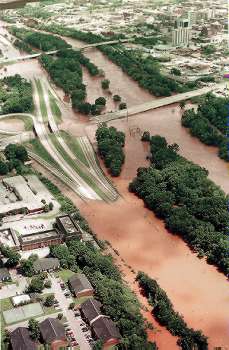
 Danny
Gilleland/The Macon Telegraph Danny
Gilleland/The Macon Telegraph----------------- |
Rising from
the waters
After the flood, renewal
By
Mara Shalhoup
The Macon Telegraph
Built atop a Jones County hill where American Indians once buried their dead, there is a $125 million miracle that a flood helped deliver.
It is a new water plant, soon to replace the one in Macon drowned by the Great Flood of '94.
Relocating and building the new facility netted the Macon Water Authority some $90 million in federal and state money and one of the best water plants in the country. The cost to the community was a fraction of its worth.
It is an emblem of the renewal that arose from the greatest natural disaster in state history.
From the mammoth water-treatment plant to 104 recuperated Montezuma businesses, the midstate - in the wake of the flood - was forever changed.
Most say it was for the better.
"The flood was a wake-up call for us," Montezuma Mayor Preston Williams said. "People during that time of disaster became more involved, more appreciative of what they have."
On July 5, 1994, what they had was nearly taken away.
Tropical Storm Alberto dumped nearly two feet of rain on Middle Georgia within 24 hours, driving 60,000 people from their homes and killing 33.
Dams were flattened. Levees broke. Highways vanished.
The damage to homes, farms, businesses and infrastructure exceeded $800 million, $200 million of which was never compensated. About 10,000 square miles of the state were under water - something weather experts expect only twice per millennium.
Middle Georgia's 500-year mark had arrived.
Today, few signs remain of the flood's destruction.
But there are marks of the progress flowing behind the greatest disaster in state history.
Some marks are visible, like the thousands of rebuilt homes and businesses.
Others aren't, like the families who learned to cope with lost loved ones.
And one might have only existed in imagination, if not for the disaster that brought money to fund it.
The old Macon water plant had sat along the Ocmulgee River since the beginning of the century. It had flooded briefly in 1990, and $10 million had been set aside to "floodproof" it.
But when the plant drowned in floodwaters deeper than anyone had imagined, leaving Macon without water for 19 days, a simple upgrade was not the answer.
If the Macon Water Authority would build a new water plant outside the flood plain to replace the one by the river, FEMA would pay 90 percent of the replacement cost.
It was an offer too good to refuse.
The new plant, expected to be operational this fall, can supply 31 percent more water than the old plant and will accommodate residential and commercial growth in Bibb, Monroe and Jones counties.
"This is one of the few times in this century that a new plant was built from scratch," said Tom Porter, public assistance specialist with the Federal Emergency Management Agency. "It's kind of a world-class project."
Other flood-damaged sites underwent similar rejuvenation.
In addition to the water plant, FEMA helped fund the revival of dozens of local lakes, including the $7 million reconstruction of a 700-foot dam at Lake Blackshear.
It took years - and more than $14 million - to repair the dams, beaches and campgrounds and bring the lakes back to normal. Some of the money came from federal aid. Some came from Warner Robins residents collecting money to get Leisure Lake back.
Most of the work is done, and many Middle Georgia lakes are safer because of it.
"I think everyone who went through it knows what can happen now," said Frank Patterson, who helped oversee some of the repairs for the Bibb County Engineering Department. "Everyone will be better prepared next time."
Not all recovery in the midstate is as thorough, though.
Even in Montezuma, where the downtown was remodeled as though it were an outdated living room, business owners still feel some of the water's burden.
About $14 million in FEMA, GEMA and private grant money was funneled into Montezuma's recovery. But no shop was compensated for ruined inventory. One man's loss exceeded $400,000.
Another business owner can't put a price on what the flood took from him: his brother.
"It might be better for the downtown in the long run," said Leroy Barker, owner of Barker's Bait & Tackle. "But you can lose a lot that you can never bring back."
He is not alone.
Dozens of families lost a parent, a spouse, a sibling or a child.
Some lost more than one, such as in Americus, where the death toll within two families accounted for a third of city's 15 flood casualties.
A local woman's husband and two sons drowned in their flood-swept truck. Another man in town lost his wife and toddler the same way.
Yet the two survivors built a future from a vanished past.
Their rebirth embodies the spirit of the community, a spirit that couldn't be dampened by disaster.